Einstein’s skateboard
Kids vying to be top young scientist of the year tackled challenges inspired by the work of Albert Einstein.
By Emily Sohn
Albert Einstein never rode a skateboard. Last month, however, skateboarders caught big air on a halfpipe in honor of the famous physicist.
In a field house on the campus of the University of Maryland in College Park, near Washington, D.C., a handful of skaters and a BMX biker took turns pulling tricks on the pipe. Off to the side, five middle-school students watched intently. With video cameras bearing down on them and a deadline approaching, the students worked frantically to solve the team’s first problem of the day.
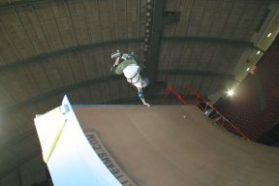 |
|
A professional skateboarder demonstrates physics in action on a halfpipe during this year’s Discovery Channel Young Scientist Challenge.
|
| Richard Cho, DCYSC |
“Our challenge,” said David Westrich, 14, of Cape Girardeau, Mo., “is to find the points along the halfpipe where skaters experience the most and least gravitational force.”
“Skateboard Physics” was one of six activities that eight teams tackled as part of this year’s Discovery Channel Young Scientist Challenge (DCYSC). Every year, the competition brings the nation’s top 40 middle-school science-fair winners to Washington, D.C., to battle for thousands of dollars in scholarship money, dream science trips, video cameras, and other prizes.
Finalists are judged individually on their ability to work as part of a team and to solve problems in clever ways. Students also need to be good at explaining their ideas. Swarms of video cameras follow contestants everywhere they go. When the week is over, the Discovery Channel produces a TV special about the event.
Star of the show
This year at DCYSC, although the students received plenty of attention, Albert Einstein was the star of the show.
Nearly 100 years ago, in one “miraculous year,” Einstein wrote three research articles that changed the face of physics forever. In one article, he showed how light could be viewed as waves of radiation or as a beam made up of particles—little bundles of energy. In another, he introduced relativity theory and later showed that energy can be converted into matter and matter into energy. Finally, he explained how tiny particles get bounced around in a liquid.
To mark the 100th anniversary of Einstein’s amazing work in 1905, the year 2005 has been designated the “World Year of Physics.” In 2000, Time magazine had named Einstein “Person of the Century.”
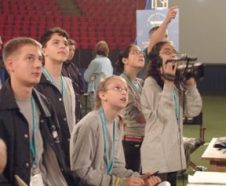 |
|
Members of the gray team watch a skateboard maneuver. From left to right, included David Westrich, David Marash-Whitman, Julia Fanning, and Celine Saucier. Teammate Sravya Keremane videotapes the action for later analysis. This group later won the DCYSC team award. |
| Richard Cho, DCYSC |
So, it’s not surprising that Einstein became the theme of this year’s DCYSC competition. “Einstein is the man,” said challenge designer Steve “Judge Jake” Jacobs. “He’s a legend.”
Einstein’s scientific achievements involved thinking in new ways. He spent his time doing “thought experiments” rather than mixing things together in a lab.
“Einstein was able to focus his thinking so perfectly,” Judge Jake said. “Here, the kids have to focus their thinking to achieve their goals.”
Judge Jake’s hope was that finalists would go home with a sense of appreciation for how brilliant Einstein really had been and a drive to be just as successful. “I hope that, just for a moment, they’ll think the way Einstein thought,” he said.
Radar guns
Four out of six challenges this year had direct connections to physics and Einstein.
In the “Skateboard Challenge,” teams had to figure out that the gravitational force was greatest as the skaters accelerated downhill and that it was smallest when the skaters reached the top, just before starting down again. They used a computer program and data from a high-definition video camera and a device called an accelerometer to test their predictions.
One of the other physics-related activities was called “Radar Gun Luge.” In it, students checked out the notion that the speed of an object, as measured by a moving observer, depends on the observer’s speed.
Finalists used radar guns to measure the speed of two luge carts. One cart held a wild-haired Einstein doll. The other carried a remote-controlled radar gun.
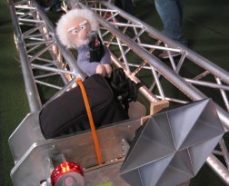 |
|
One luge cart carried an Albert Einstein doll.
|
| Emily Sohn |
Team members had to drag the carts to the top of two steep tracks, then release the carts at the same time. Altogether, they had 90 minutes to confirm that the doll’s measured speed was twice as fast when measured from the other cart moving toward it as when it was measured by an observer standing at the side.
If this sounds confusing to you, you’re not alone. More than halfway through the activity, the red team was looking visibly shaken. “All of our data is useless,” said Nicholas Ekladyous, 14, from Imlay City, Mich., with a hint of panic in his voice.
“We have no data,” answered his teammate Rebecca Chan, 13, from Encinitas, Calif.
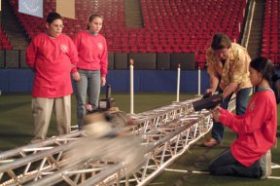 |
|
Nicholas Ekladyous (left) and Anastasia Roda watch a cart whiz by as Rebecca Chan measures its speed using a radar gun.
|
| Richard Cho, DCYSC |
Discussion about what to do next rapidly turned sour. With just 10 minutes left, Nick was trying to persuade his teammates that they should abandon their original strategy and make a new plan. “Nick,” Rebecca said, “it’s going to take you longer to talk us out of this than for us to just do it.”
After that temporary breakdown, it was on to the next challenge.
Obstacle course
Teamwork was the key to success.
In “Laser Obstacle Course,” teams had to use a limited number of mirrors to send a laser beam under, around, and through a series of obstacles. To succeed at this task, it helped to know the laws of reflection and the fact that laser beams tend to become wider the farther they travel.
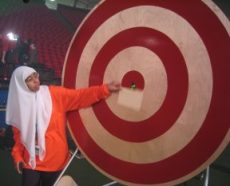 |
|
The teams had to get a laser beam past various obstacles, including this target, which has a small hole at its center. Here, the orange team’s Maryam Khadijah Mohammed checks the beam.
|
| Emily Sohn |
The teams that were most successful, however, were the ones that sat down first, came up with a plan, and worked together to make it happen. Remarkably, every team that succeeded came up with a different solution.
In “Teeth on Edge—A Real Screech,” teams had to compose, perform, and record a musical piece, based on the opening theme from Beethoven’s Fifth Symphony. What made the challenge especially tricky was that the instruments the students could use were all very unusual. And each instrument was missing certain pieces.
So, team members had to figure out what was missing, make the missing pieces, tune the completed instruments, then compose and perform a musical piece. There was no “right” answer, but the performance had to involve the whole team, and team members had to agree on what sounded good.
The gray team, which finished the 2-day competition with this activity, chose to include a human voice as one of their instruments. As a baritone, David Westrich repeated the phrase “fifteen thousand dollars” in time with the music. The team hoped this creative touch would help sway the judges.
The team did, in fact, win the overall team prize—not $15,000 but a trip to Yellowstone National Park to study wolves. And David won third place, a $3,750 scholarship.
“We’re the fun team!” said Julia Fanning, 13, who traveled to D.C. from San Antonio, Texas. A member of the gray team, she ended up winning a digital camera for her patience as a problem solver. Of course, all the teams described themselves as “fun teams.”
Beyond physics
The competition included two tasks that had practically nothing to do with physics.
One, called “Skulls Unlimited,” challenged students to identify up to 40 animals, given only skeletons or skulls. The students could check reference materials or ask questions to obtain clues that would help them pin a name to a given skeleton.
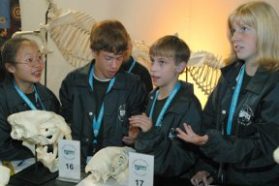 |
|
Green team members (from left to right) Janet Song, Kyle Yawn, Blake Thompson, and Shannon McClintock ask questions as part of trying to identify the animal to which a skull belongs. Shannon was later named top young scientist of the year.
|
| Richard Cho, DCYSC |
In another challenge, called “Paramecium Rodeo,” finalists had to identify microorganisms, then use high-tech equipment to capture images of these creatures.
For this year’s finalists, take-home lessons went far beyond physics. “I learned that it doesn’t matter where you get as long as you stick to what you found,” said Shannon McClintock, 14, from San Diego, Calif. Shannon did that well enough to win first place, a $15,000 scholarship for college.
“Everyone keeps repeating it,” she said. “Process matters more than results. Stick to it.”
The young scientists also confirmed that doing experiments can be fun and liking science doesn’t make you a loser. At the awards ceremony at the end of the competition, student speaker Adam Tazi, 14, of Orlando, Fla., described how delightful it was to spend time with other kids who shared his interests.
Adam won The Learning Channel’s “Hot Rod” award—a trip to Los Angeles to go behind the scenes at two TV shows about cars, “Overhaulin'” and “Rides.”
“I expected to come here and spend the week with a bunch of national-level science geeks,” Adam said. “But you guys are so cool. I’ll miss all you guys.”
Going Deeper:







